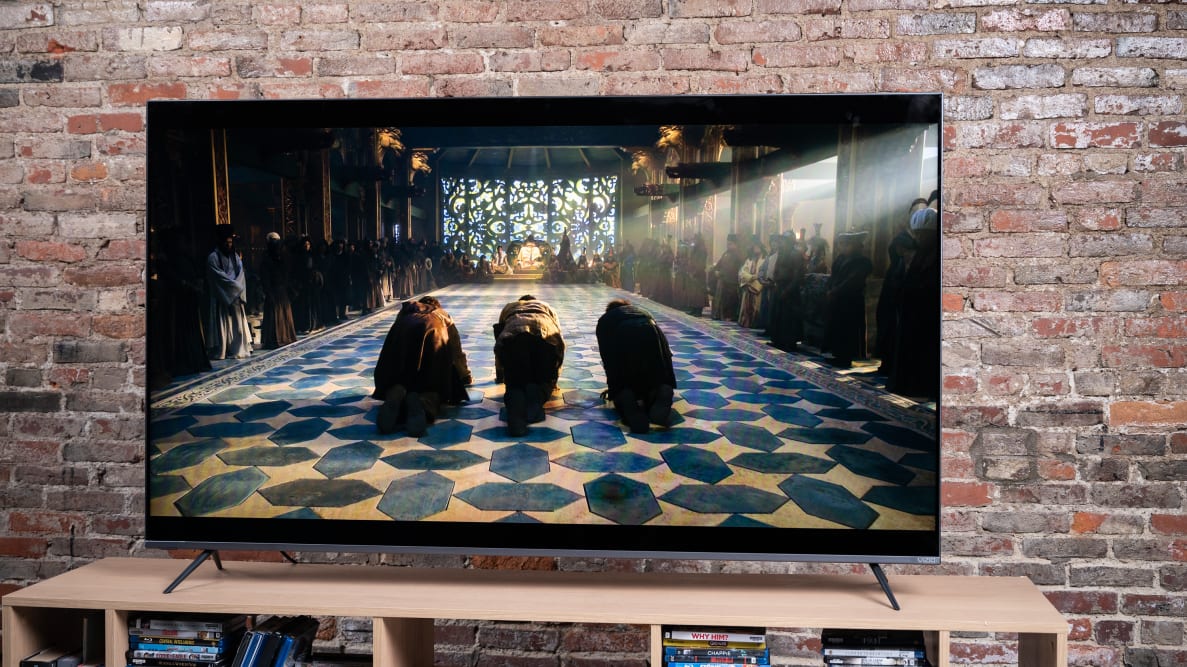Pros
-
Solid picture quality
-
120Hz refresh rates
Cons
-
Software can be sluggish
The P-Series Quantum is positioned between the excellent P-Series Quantum X and the more affordable M-Series Quantum. As you might guess from the naming scheme, almost all of Vizio’s 2020 TVs feature quantum dots, microscopic nanocrystals that enhance color saturation. They also all feature full-array local dimming (FALD) backlights, which make for better than average contrast—especially during HDR viewing.
Time in the lab revealed something we already assumed: the P-Series Quantum is excellent. For what you’re paying, you’re getting comparable contrast performance to Samsung’s pricier Q80T lineup, plenty of color, and a huge array of features for a lot less than the competition. In fact, the only reason to spring for the higher-end Quantum X is if you really want top-of-the-line brightness and color performance.
Is the P-Series Quantum for everyone? No—120 Hz native refresh rates, Auto Low Latency Mode, and Dolby Atmos support are specs geared for a certain kind of buyer. However, if you’ve been looking for a home theater-worthy TV with a price point close to $1,000, the P-Series Quantum’s only real competition is TCL’s 6-Series—and the Quantum may be the better choice for certain viewers.
(Note: Due to COVID-19 complications, this review leans heavily on test results in lieu of hands-on time with the TV.)
About the Vizio P-Series Quantum (2020)
Vizio’s 2020 P-Series Quantum is available in just two screen sizes:
- 65-inch (Vizio P65Q9-H1), MSRP $1,199.99
- 75-inch (Vizio P75Q9-H1), MSRP $1,699.99
The 65-inch and 75-inch P-Series Quantum are functionally identical, but they do differ in one notable way: the number of local dimming zones. The 65-inch model apparently has 200 local dimming zones while the 75-inch sports 240 zones. The 75-inch model may also be brighter, but as we tested a 65-inch sample in our lab, we can’t say for sure just yet.
Otherwise, these are the noteworthy specs the TVs share:
- Resolution: 4K (3,840 x 2,160)
- Display type: VA LCD
- Backlight type: Full-array LED
- Local dimming: Full array local dimming, 200-240 zones
- HDR format support: HDR10, HDR10+, HLG, Dolby Vision
- Dolby Atmos compatible: Yes
- eARC support: Yes
- Native refresh rate: 120 Hz
- Variable refresh rate (VRR) support: Yes
- Smart platform: Yes, Vizio SmartCast
- Chromatic resolution: 10-bit
- Native color space: DCI-P3
- Auto Low Latency Mode (ALLM): Yes
- Other features: Google Assistant, Amazon Alexa, Apple AirPlay, Chromecast
What differentiates the P-Series Quantum from Vizio’s top-of-the-line P-Series Quantum X? Essentially, the pricier PQX features more local dimming zones and higher brightness, which allows it to eke a little more color saturation out of its quantum dot film.
However, from design elements to almost all of the extra features and compatibilities, these series are very similar.
Performance Data
Before testing a TV, we set it up in the lab to receive a continuous signal over a number of hours. This moving pattern prevents screen burn/image retention while "breaking in" or warming up the panel. Our 65-inch Vizio P-Series received this standard warm-up before test data was gathered.
For "SDR" measurements, we used the "Calibrated" picture mode pre-sets, while for "HDR" measurements, we used the "Calibrated HDR" picture mode. We chose these picture modes because of their apparent accuracy, but the results below will likely be noticeably different depending upon which picture mode you use.
Lab testing involves sending standardized test patterns from a Quantum Data 780A signal generator, and performing sweeps of SDR and HDR test patterns using SpectraCal's "CalMan Ultimate" software. Here are some key takeaways from the Vizio P-Series Quantum's time in the lab:
- HDR Contrast (brightness/black level): 614.60 nits/0.056 nits (ANSI checkerboard)
- SDR Contrast (brightness/black level): 372.40 nits/0.027 nits (ANSI checkerboard)
- HDR peak brightness: 1,022 nits (40% window)
- HDR color gamut coverage: 97.9% (DCI-P3/10-bit)
- SDR color gamut coverage: 100% (Rec.709)
Connectivity
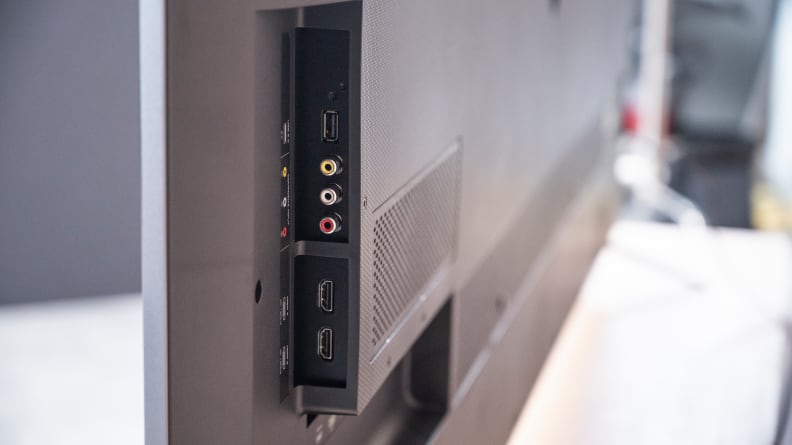
The Vizio P-Series Quantum (2020) nets you four HDMI 2.1 inputs, as well as options for older (AV) connections, an ethernet hookup, and various audio outputs.
The Vizio P-Series Quantum couldn't offer features like variable refresh rate (VRR) and auto low latency mode (ALLM) without HDMI 2.1 compatibility, but fortunately, that's what you're getting here. If you own (or plan on owning) an Xbox Series X or PlayStation 5, this TV could make for a good pairing.
On the back/side of the panel, you'll find the following connectivity options:
- 4x HDMI 2.1 (1x eARC)
- 1x USB 2.0
- LAN ethernet port, RF input, optical audio output, analog audio output ***
What We Like
A balance of light and dark
When it comes to picture quality—especially in the days of High Dynamic Range—contrast is king. As far as your eye is concerned, the most noticeable aspect of any TV is how much differentiation there is between its brightest and darkest points.
Vizio may only have just dipped a toe into the OLED TV market, but the company has been producing highly viable LED TVs for years. While a lot of folks will point toward the TCL 6-Series in the $1,000 price range, there’s good reason to take a closer look at the P-Series Quantum where contrast is concerned.
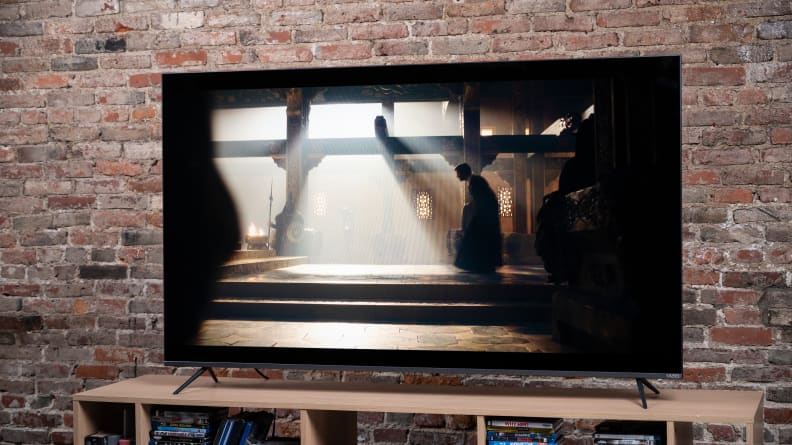
The P-Series Quantum boasts similarly high brightness compared to TCL's 6-Series TVs, but generally better black levels overall.
The 2020 TCL 6-Series boasted a peak brightness of around 1,000 nits when displaying HDR content. While impressive, its reference black level during that display of brilliance was a little high at 0.09 nits. It’s not bad given the TV’s brightness, but it could be distracting for discerning watchers in a dark room. By comparison, time in the lab with the P-Series Quantum revealed similar peak brightness, but a comparably much better black level (around 0.05 nits). From a sheer numbers perspective, the P-Series Quantum may be the better choice if you want a more OLED-like experience.
Of course, if you really want serious brightness, it might make sense to consider stepping up to Vizio’s P-Series Quantum X, which reaches almost 2,000 nits of brightness while maintaining the same excellent black level. Just be ready to shell out about $500 more per screen size.
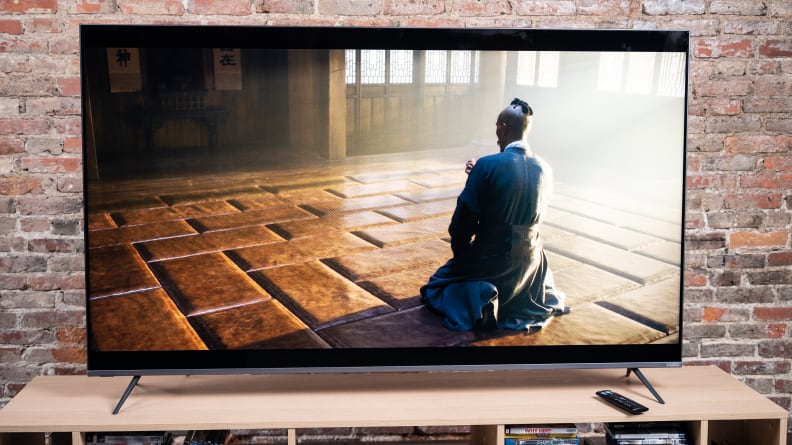
Because it uses a full-array backlight, the P-Series Quantum delivers the most brightness when large swaths of the screen are lit up.
It’s also worth noting that Vizio claims a peak brightness of 1,200 and 1,100 nits for the 75- and 65-inch P-Series Quantum, respectively. While we don’t doubt the TVs can hit those numbers in “Vivid” mode with ideal test patterns, our measurement of ~1000 nits in the darker, less flashy “Calibrated” mode is a more realistic idea of what you’ll actually be seeing most of the time.
Rich, accurate color on all fronts
Newer, souped-up HDR TVs tend to come out of the factory finely tuned for HDR content, not standard (SDR) content. We test a lot of TVs that can match or exceed the HDR color space (DCI-P3), meaning they produce the proper colors for HDR but don’t match up as well during standard content.
The P-Series Quantum doesn’t have that problem. Lab testing revealed that it fully takes advantage of its quantum dots, producing vivid HDR colors—exactly what you’d expect for this price. It also matched the older, standard color space almost perfectly, so it doesn’t sacrifice the old in favor of the new.
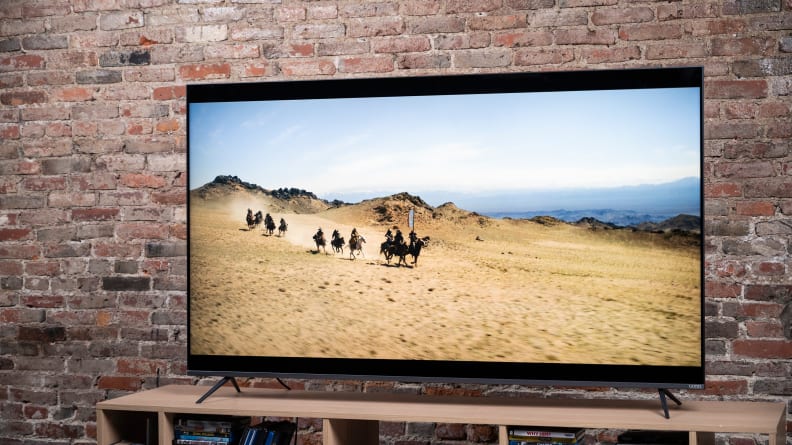
The P-Series Quantum tested with highly accurate RGB balance and color saturation in the "Calibrated" and "Calibrated HDR" picture modes—right out of the box.
Regardless of color space, we also want to see TVs producing a certain “flavor” of white light. This reflects the relative emphasis of red, green, and blue within its grayscale production (often called “color temperature”), and whether you’re watching SDR or HDR content, there’s a single “correct” flavor: 6500 Kelvin. While the P-Series Quantum didn’t perfectly hit 6500K across the grayscale spectrum, it never ranged above 6549K or below 6300K during SDR measurements, an amount of difference that’s imperceptible to human eyes (the range was a bit wider in HDR, but never excursed beyond noticeable differences).
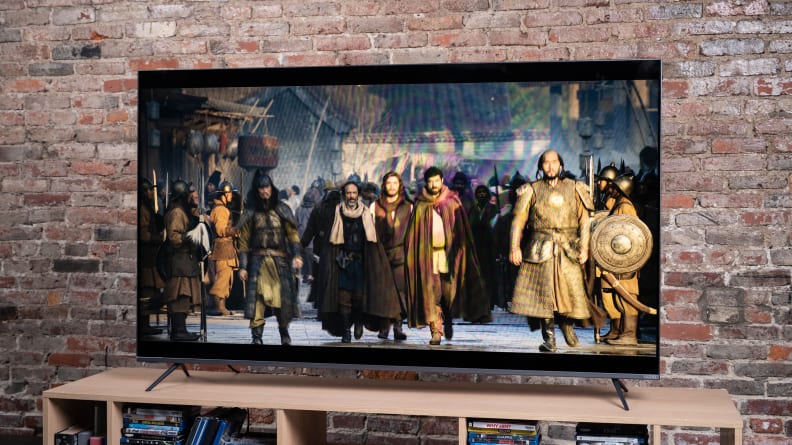
The TV's accurately calibrated color temperature mean it does particularly well representing the many subtleties of various skin tones.
All of these readings were taken with the P-Series Quantum’s pre-calibration settings, so whether you’re watching basic cable or a Blu-ray, you can expect accurate, balanced grayscale and color tones right out of the box.
Bright, colorful content like nature documentaries will look realistic, while harder-to-produce, low-light colors will still hold up during more filmic content. You can expect a color-accurate experience regardless of content.
Everything & the kitchen sink
The P-Series Quantum is kitted out for compatibility and flexibility. It covers all the basic HDR formats (including Dolby Vision), supports eARC and Dolby Atmos, and offers both VRR (Variable Refresh Rate) and ALLM (Auto Low Latency Mode), features that can really boost responsiveness while playing video games.
As features go, the P-Series Quantum is equal to the top-tier P-Series Quantum X: you’re still getting a native 120 Hz refresh rate, similar processing power, and format compatibility. The pricier Quantum X is brighter and can produce more saturated colors, but the “guts” are almost identical, so far as we can tell.
If you’re not sure you need all of this cheddar, you could always opt for something a lot cheaper like the M-Series Quantum. But if you do want these forward-facing features, the P-Series Quantum offers them for much less than most of the competition.
Finally, you’re getting a wealth of connectivity options on the back of the panel: five HDMI inputs, a component/composite splitter hookup for older models, USB ports, an ethernet (LAN) input, Dolby Digital output, and ARC/eARC compatibility. Whether you just want to plug in a cable box or (more likely in this TV’s case) a few source devices or game consoles, the P-Series Quantum won’t slow you down.
Good enough design for most folks
When it comes to cutting-edge design, Vizio is not often leading the pack. To maintain lower costs, the company sticks to TVs that are fairly dressed down: see Exhibit A, Rectangular Charcoal Screen.
The P-Series Quantum is certainly a step up from the lower-tier M-Series Quantum, which is about as plain as TVs get, but it doesn’t get overly fancy like some of the OLED or “Lifestyle” TVs out there. The Quantum looks almost exactly like the flagship Quantum X, featuring minimalist bezels around the screen and a fairly slim slide profile for a TV with a full-array LED backlight.

These TVs feature minimalist bezels and space-saving, caltrop-shaped feet. The design is fairly plain, but will fit into most living rooms perfectly.
Like almost every Vizio TV for the last few years, you’re getting wide-set, caltrop-shaped feet instead of the traditional tabletop stand; you’ll find all of the connectivity ports on the back of the panel; and the included remote is standard fare, featuring volume/channel rockers and a multitude of buttons.
It’s also worth remembering that as a TV reviewer, I’m over-exposed. I imagine to most people who haven’t been checking out $3,000 TVs full time, the P-Series Quantum's aesthetic will look sleek and pleasingly minimal.
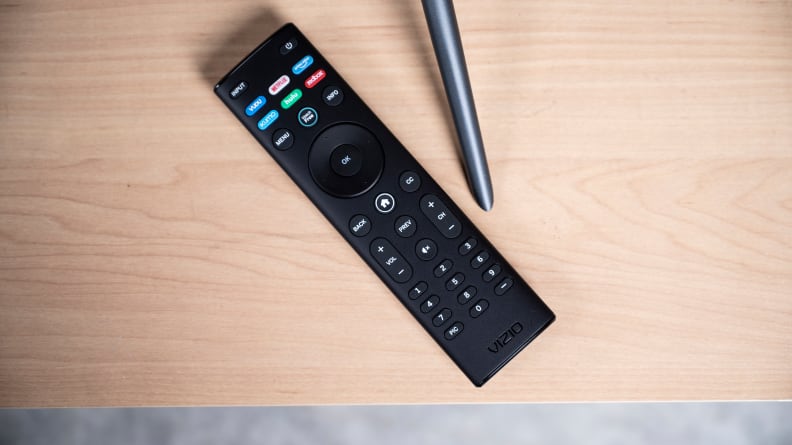
The included remote is standard Vizio TV fare, featuring a full button array and a number of app hotkeys.
A solid choice for gamers
While Vizio’s had to do some firmware finagling since last year to get all of the HDMI 2.1 features working across the 2020 lineup, the P-Series Quantum’s inclusion of VRR (variable refresh rate), ALLM (auto low latency mode), and 1080p input lag results as low as 30ms in the “Game” picture mode should mean that this TV is a fine option for folks looking to get their game on.
What We Don't Like
Sound doesn’t fit the picture
While the P-Series Quantum boasts very good picture quality, its built-in speakers are sure to fall short of matching that display fidelity.
This is true of almost every TV nowadays, but if you’re investing in high-fidelity 4K/UHD picture quality, there’s a good chance you’ll want the audio quality to match. On the plus side, the P-Series Quantum saves you money compared to a similarly spec’d option like the Samsung Q80T, so picking up an decent soundbar is always an option.
SmartCast may let you down
When it comes to Vizio’s SmartCast platform, the story is usually the same. The company pours a lot of R&D into tweaking and perfecting its backlight functionality while continuing to update TVs to handle the latest HDR or gaming-related specifications (see: the recent HDMI 2.1 update for 2020 models).
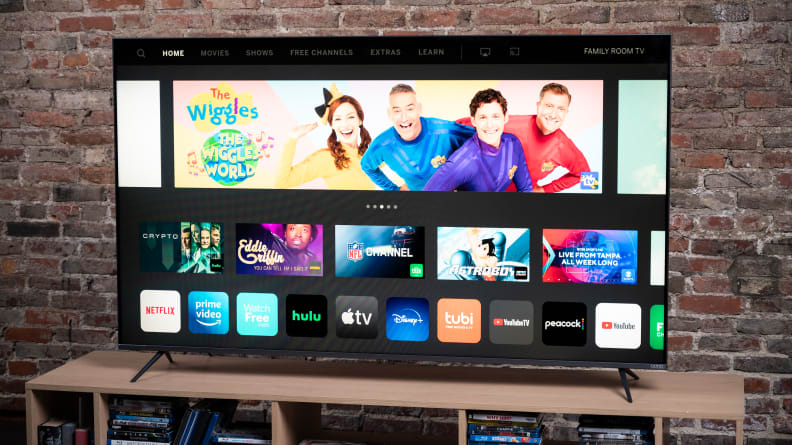
Vizio's smart platform will work fine for lots of people, but we generally recommend investing in a streaming device.
This is great news where lots of functionality is concerned, but over time, all of the updates to firmware and on-board apps start to really slow the TVs down. We’ve seen this happen year after year: SmartCast (and the on-board menu system in general) are snappy and responsive for the first year or so, but two or three years in start to feel like molasses rolling uphill.
Your best bet is to just minimize how often you have to try to use the TV software and opt for a great streaming device. Like the TV’s sound quality, SmartCast isn’t bad, but doesn’t live up to the sheer polish you’re getting in terms of brightness, contrast, color accuracy, and refresh rate.
Should You Buy It?
Yes—if you know exactly what you want
The Vizio P-Series Quantum is a great TV, especially with the 65-inch regularly available for less than $1,000. The best way to understand its value, however, is to look at the competition.
As LED TVs go, Vizio’s P-Series Quantum is competing with TCL’s 6-Series and Samsung’s QLED lineup. The Samsung Q80T asks you to pay a few hundred dollars more for roughly the same performance, and while the 65-inch TCL 6-Series might be tempting at only $900 or less, the P-Series Quantum boasts a better HDR black level and more local dimming zones, which goes a long way towards improving its general performance in subtle ways.
I’m not going to claim that the P-Series Quantum is all-out a better TV than the TCL 6-Series. The latter—with its friendlier price point, Roku smart platform, and high brightness—is the better fit for most people. But if you’re picky about shadow quality and despise backlight bleed, paying just a little more for the P-Series Quantum might be just the ticket.
Meet the tester
Lee was Reviewed's point person for most television and home theater products from 2012 until early 2022. Lee received Level II certification in TV calibration from the Imaging Science Foundation in 2013. As Editor of the Home Theater vertical, Lee oversaw reviews of TVs, monitors, soundbars, and Bluetooth speakers. He also reviewed headphones, and has a background in music performance.
Checking our work.
Our team is here to help you buy the best stuff and love what you own. Our writers, editors, and experts obsess over the products we cover to make sure you're confident and satisfied. Have a different opinion about something we recommend? Email us and we'll compare notes.
Shoot us an email